.
Impressionism
Claude
Monet
(1840-1926)
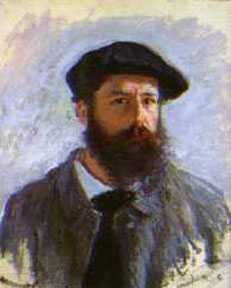
Self Portrait
|
|

Impression, Sunrise 1872
|
Claude Monet became the
"Father of Impressionism" when he exhibited this painting
of a boating scene at sunrise. His manner of painting with loose brushstrokes
and bright colors in a sketchy manner prompted a writer to mimic the
title in a newspaper essay. Calling him an "impressionist"
was meant to be an insult, but the term stuck because it fit the ideals
of the artist and his followers.
The Impressionists in general
are known for painting out of doors in a direct and painterly manner.
It is a movement which had its beginnings in Paris among a group of
artists who knew each other. Though Monet's early paintings of this
style often include figures, he soon discovered that it was the landscape
which most captured his interests.
|
Poplar
Trees Series:
Monet often painted the same subject over and over again, coming back to
a scene to observe the changing light and weather conditions. Above is a
cluster of poplars painted along the Epte River in 1891. Below are some
samples of the many paintings he created on the subject of the Houses of
Parlaiment. You will notice, in this case, that the composition is almost
exactly the same - but that the changing colors are a result of different
times of day and lighting conditions. One might easily say that he is not
painting the Houses of Parlaiment at all. The buildings merely provide the
composition, but the true subject is light and color.
The Houses
of Parlaiment Series:
Waterlilies
at Giverny
|
Monet's most famous
series of paintings are those which occupied his later years of life.
After achieving fame for his earlier paintings, Monet secluded himself
to his garden at his home in Giverny, France. There, he had a waterlily
pond and a Japanese bridge. The earlier paintings of this series usually
include the gardens or the bridge, but the later works focused on the
lily pads,flowers and reflections of the sky in the water. By ridding
the compositions of a horizon line, the artworks become much more abstract.
In addition, these paintings are generally much larger than the previous
ones. To observe them is to fall into a mass of colors and dissolving
forms. Only when backing up does the viewer even perceive the forms of
the lily pads. I have noticed that the flowers are painted with much thicker
paint than the rest, which helps them to jump out from the painting. |

August
Renoir
(1841-1919)
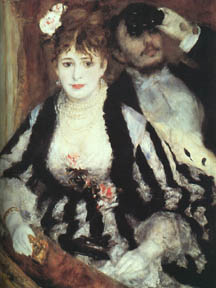
The Theater Box,
1874
|
|
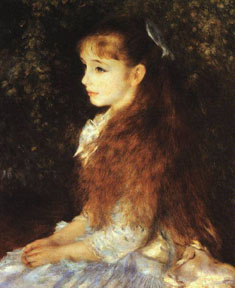
Irene, 1875
|
Renoir was a painter of people.
Like Monet, he was interested in light and how it defined the passing moment
- but he rarely painted without images of people enjoying themselves. It
is important to note that these are always modern people. They are
his contemporaries: primarily middle-class Parisians enjoying their leisure
time in outdoor or cultural events. It is part of the Impressionist aesthetic
that he was interested in the changing moment: the sense that everything
is about to change if you were to look away and bring your eyes back to
the scene. The dappling lights and shadows, the chatter of conversations,
and Parisian music emanate from his canvases.
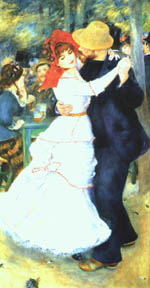
Dance at
Bougival, 1883
|
|
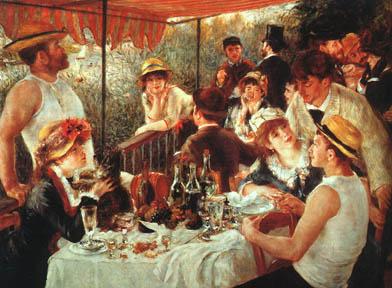
Luncheon of the Boating
Party, 1881
|

Detail from Luncheon of
Boating Party
|
One of the most enjoyable aspects of Renoir's paintings is his feather-light
brushstroke. A detail of the glasses from the Boating Party reveals that he
never painted with distinct outlines, but with a wispy stroke that just barely
captures the form. As with many impressionist artworks, the forms are clearer
from a distance and seem to de-materialize on close scrutiny.
Renoir's favorite subjects were women. Whether clothed or unclothed, Renoir's
women always have a fleshy softness and sweet expressions. Rosy-cheeked children
also frequently occupy his canvases. One cannot help but question if the world
Renoir percieved was really as sweet and pretty as the one he presents to
us. Renoir chose to concentrate on images that were cheerful and bright, and
full of optomism.
|